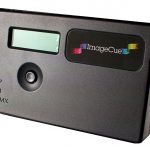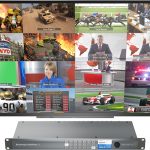Different Lengths, Resolutions
These fixtures can be used in a plethora of different applications — from lining the edges of scenery on stages to incorporating them into TV game shows to building unique shaped structures out of them to make an artsy sculpture. The fixtures themselves come in two different sizes — one meter (39.37 inches) or 320mm (12.6 inches). This choice will help set designers who need specific lengths for their projects. The fixtures can butt up to each other seamlessly to become one. Martin has an optional coupler bracket that easily slides into the ends of two adjacent fixtures, allowing them to connect as one with the use of some wing nuts.
The fixtures are sold in different resolutions as well. While the one-meter section of Sceptron 10 has precisely 100 RGB LEDs in a row, Martin also offers resolutions that are lower-res, at 20mm, and another model where the pixel-pitch is 40mm. The height and width of these fixtures are barely over an inch in size without any lens covering. They weigh under a pound per foot despite the fact that they are rock hard and do not flex at all. Brightness of the LEDs will be approximately 70 percent after 50,000 hours.
 Lens and Hardware Options
Lens and Hardware Options
Standing alone, the LED strip is very bright. A single one-meter strip of the VDO Sceptron 10 emits 750 lumens. While it only has red, green and blue LEDs like all video tiles, it gives off a very beautiful 6500°K daylight white beam when all colors are mixed to full, using DMX as a control signal. Without any covering, the beam is a good light source. Its beam radiates outwards at a 120° angle.
That’s when the beauty of the optional diffuser lens comes in play. The diffusers spread the light outwards in a wider direction. The lens itself is a white plastic front that easily snaps on to the face of the fixture without any tools. There are several options available with these models. There is a perfectly round one that snaps on so your fixture can resemble the old discontinued Versatubes of the past. They also make a half-moon shaped one as well as a square diffuser. A flat diffuser barely covers the LEDs. Each one looks different to my eye, and I like them all. Many scenic designers hate the look of the white diffuser covers on other products when the LEDs are turned off. Martin has aided them by offering the diffusers in a smoky color as well so they are not as noticeable when not in use.
On the other end of the spectrum, Martin is also offering a narrow lens soon, that will concentrate the light emitted into a tight 20° beam. This works great for cove lighting, uplighting any flat wall of scenic backdrop as well.
 Ready for Rigging
Ready for Rigging
The back of the fixture has a slotted track similar to any unistrut device. Attaching half couplers and other clamps is pretty simple with the proper hardware. One can easily attach eyebolts to hang the fixture down on some wires for architectural use.
Even without the diffusers, the fixture has an IP65 rating so it can withstand some rain elements easily. Each fixture has a single proprietary cable (male and female) attached to the bottom of the fixture for ease in daisy chaining the fixtures together. The screwed tight connector has two pins for the 48V DC required to power up the fixture and additional pins for the signal. One can daisy-chain many of these together, and the power supply can be located up to 50 meters away from the first fixture in line.
I am not thrilled with the individual cables sticking out of the back. But by doing this, both connectors ensure a sealed connection, shielding the fixture from moisture. Even so, this means one must use standoff pieces to attach the fixture directly to any surface. I fear the cables may wear down over time packing in road cases. But speaking of cases, Martin does offer some nifty ones that can hold 10 one-meter fixtures or 30 of the shorter ones.
 Control
Control
The best way to control these fixtures is through the use of a media server and the Martin P3 processor, the same unit they use to power up their other video products. This way, the user can feed any video signal into the processor easily through SDI or DVI connectors and easily map the pixels in the processor.
The video processor also allows you to calibrate brightness and color temperature on the fixtures so they all look the same, regardless of their current lifespan. The P3’s output capacity of two million pixels allows me to manage a variety of devices from a single controller. It allows real-time integration with automation and lighting control via DMX, Art-Net and Kinesys K2 interfaces.
Some may wish to use DMX to control these. If you were at a trade show and just needed to light a long header with a row of blue light, you wouldn’t want a media server. Or maybe a touring show just needs a handful of these to light a set and don’t otherwise need to have a media server traveling with the show; in that case, DMX control would be a good solid second option. Keep in mind, however, that these units can eat up a ton of DMX channels, especially if you use them to their full visual potential. I can run this model on just three channels of DMX for the RGB values. But that is considered running the fixture as a “board only” mode, where the user has no control over the individual pixels. I would much rather use all 307 channels they offer in the extended mode.
Of the total 307 channels, 300 are for the colors of the individual LEDs. The intensity requires two channels, as the Sceptron runs in 16-bit mode. There are an additional two channels for strobe functions and rates. Lastly, the fixture has three channels for built-in effects.
Right away, I notice how simple it is for me to run various effects and chases from my console. The fixture is like LED tape on steroids — it’s incredibly bright with vivid colors. Yellow, lavender and teal are no problem to achieve by simple color mixing. I test out the various effects, from cool strobe peels to various in-and-out color sequences. They show me that these fixtures are capable of producing plenty of eye candy.
At a Glance
Video Building Blocks
Martin Professional’s VDO Sceptron family includes linear outdoor-rated LED video fixtures with 10mm, 20mm or 40mm pixel pitch with an extensive range of field-exchangeable optical accessories that offer a wide variety of looks. Controlled by the Martin P3 system controllers, VDO Sceptron fixtures promise simple configuration, mapping and setup.
VDO Sceptron Family
PROS: Lightweight, sturdy, numerous lens options, easy to hang.
CONS: Permanent cable leads attached.
SPECS
Width: 1.07”
Height: 1.1”
Weight: 0.81 lbs. per foot
Options
Pixel Pitch/Length:
- 10/20/60mm Pixel Pitch
- 1 meter/320mm Lengths
Diffuser Options:
(Smoked or Non-Smoked)
- Flat
- Round
- Square
- Tube
- None
MSRP:Contact your Martin representative.
More Info: www.martin.com, www.plsn.me/VDO-Sceptron (video)



